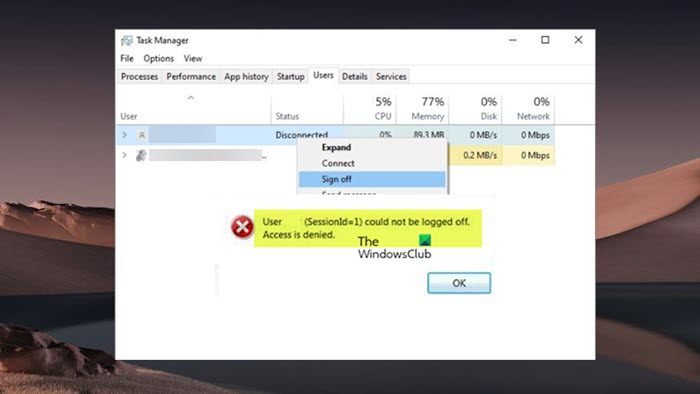Besides the obvious insufficient permission to perform the intended task, the two reasons why you may encounter this issue are:
Firstly, it is possible that the user is not logged in at all – in which case they would not have an account with which to log off.Secondly, the user’s account may have been disabled – in which case they would not be able to log off using their username.
Read: Someone else is still using this PC; What does it mean?
User (SessionID) Could not be logged off, Access is denied
If you receive the User (SessionID) Could not be logged off, Access is denied prompt when you try to sign out or log off other users from a current session via Task Manager on Windows 11/10 PC, then the suggestions we have outlined below in no particular order is sure to help you resolve the issue. Let’s look at the description of these suggestions.
1] Restart the PC
This is the easiest way to log off a user on a PC when you get the User (SessionID) Could not be logged off, Access is denied error. Save any unsaved work on the currently logged-in account and restart the system. When the computer boots again, all user sessions will have been terminated and users will be required to sign in again to start a fresh session. Read: Why does restarting your Windows PC fix so many problems?
2] Run Task Manager with admin privilege
It is possible that Task Manager is not running under administrative privileges hence the all-too-common access denied error message. In this case, to resolve the issue, you can use any of the methods in this guide to run Task Manager with admin privilege and then try logging off the user on the PC. Read: Access denied, Please log in with administrator privileges and try again
3] Terminate the user’s explorer.exe process
If you get access denied even when you run Task Manager with admin privilege and you are logged in as admin on the computer, you can terminate the user’s explorer.exe process from the Task Manager. After that, you should be able to successfully log the user(s) off. Read: Manage Users in Windows with Quick User Manager
4] Login using a Local account with admin privilege or the inbuilt Administrator account and log out the user
If you’re signed in on the computer with a Microsoft Account, you can sign in with a local account instead or change a standard user account to an administrator account and then log off the user. Alternatively, although it might be overkill (but, if it solves the problem at hand, then good), you can enable built-in Administrator Account (make sure to disable the account once done with the task) in Windows 11/10, log into the account and log off the user account throwing the error in view. Read: You need to sign in as an administrator to continue I hope you find this post helpful! Now read: Deleted User Profile by mistake and now can’t log in to Windows
Why am I getting an access denied message?
The Access Denied error can occur in different instances. Sometimes specific, and other times just generic. However, in most cases, it usually has to do with permissions. In a typical scenario, the error appears when your browser uses different proxy settings or VPN instead of what’s set on your Windows 11/10 PC. Thus, when a website detects that there is something wrong with your browser cookies or your network, it blocks you and you won’t be able to access the website.
How do I get rid of access denied in Windows?
If you’re getting access denied (for example, when trying to open a file/folder) in Windows 11/10 even if signed in as an admin on the PC, you need to check and change the file/folder permissions. To do this, right-click the file or folder, and then click Properties. Click the Security tab. Under Group or user names, click your name to see the permissions you have. Click Edit, click your name, select the check boxes for the permissions that you must have, and then click OK. Also read: System error 5 has occurred, Access is denied in Windows.


